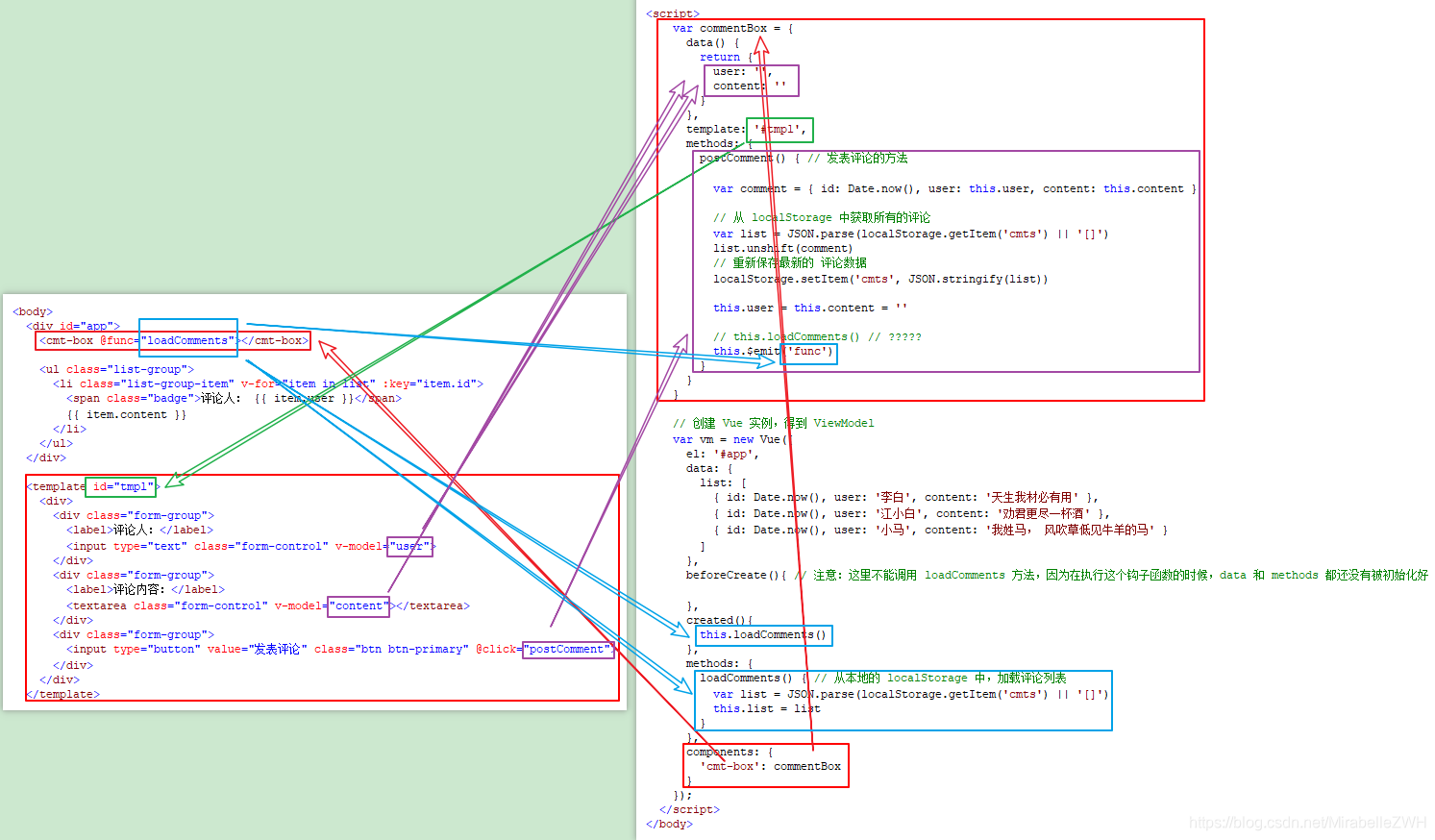定义Vue组件
组件: 组件的出现,就是为了拆分Vue实例的代码量的,能够让我们以不同的组件,来划分不同的功能模块,将来我们需要什么样的功能,就可以去调用对应的组件即可;
组件化和模块化的不同:
- 模块化: 是从代码逻辑的角度进行划分的;方便代码分层开发,保证每个功能模块的职能单一;
- 组件化: 是从UI界面的角度进行划分的;前端的组件化,方便UI组件的重用;
全局组件定义的三种方式
- 使用 Vue.extend 配合 Vue.component 方法:
var login = Vue.extend({
template: '<h1>登录</h1>'
});
Vue.component('login', login);
- 直接使用 Vue.component 方法:
Vue.component('register', {
template: '<h1>注册</h1>'
});
- 将模板字符串,定义到script标签种:
<script id="tmpl" type="x-template">
<div><a href="#">登录</a> | <a href="#">注册</a></div>
</script>
同时,需要使用 Vue.component 来定义组件:
Vue.component('account', {
template: '#tmpl'
});
注意: 组件中的DOM结构,有且只能有唯一的根元素(Root Element)来进行包裹!
组件中展示数据和响应事件
- 在组件中,
data需要被定义为一个方法,例如:
Vue.component('account', {
template: '#tmpl',
data() {
return {
msg: '大家好!'
}
},
methods:{
login(){
alert('点击了登录按钮');
}
}
});
- 在子组件中,如果将模板字符串,定义到了script标签中,那么,要访问子组件身上的
data属性中的值,需要使用this来访问;
【重点】为什么组件中的data属性必须定义为一个方法并返回一个对象
- 通过计数器案例演示
使用components属性定义局部子组件
- 组件实例定义方式:
<script>
// 创建 Vue 实例,得到 ViewModel
var vm = new Vue({
el: '#app',
data: {},
methods: {},
components: { // 定义子组件
account: { // account 组件
template: '<div><h1>这是Account组件{{name}}</h1><login></login></div>', // 在这里使用定义的子组件
components: { // 定义子组件的子组件
login: { // login 组件
template: "<h3>这是登录组件</h3>"
}
}
}
}
});
</script>
- 引用组件:
<div id="app">
<account></account>
</div>
使用flag标识符结合v-if和v-else切换组件
- 页面结构:
<div id="app">
<input type="button" value="toggle" @click="flag=!flag">
<my-com1 v-if="flag"></my-com1>
<my-com2 v-else="flag"></my-com2>
</div>
- Vue实例定义:
<script>
Vue.component('myCom1', {
template: '<h3>奔波霸</h3>'
})
Vue.component('myCom2', {
template: '<h3>霸波奔</h3>'
})
// 创建 Vue 实例,得到 ViewModel
var vm = new Vue({
el: '#app',
data: {
flag: true
},
methods: {}
});
</script>
使用:is属性来切换不同的子组件,并添加切换动画
- 组件实例定义方式:
// 登录组件
const login = Vue.extend({
template: `<div>
<h3>登录组件</h3>
</div>`
});
Vue.component('login', login);
// 注册组件
const register = Vue.extend({
template: `<div>
<h3>注册组件</h3>
</div>`
});
Vue.component('register', register);
// 创建 Vue 实例,得到 ViewModel
var vm = new Vue({
el: '#app',
data: { comName: 'login' },
methods: {}
});
- 使用
component标签,来引用组件,并通过:is属性来指定要加载的组件:
<div id="app">
<a href="#" @click.prevent="comName='login'">登录</a>
<a href="#" @click.prevent="comName='register'">注册</a>
<hr>
<transition mode="out-in">
<component :is="comName"></component>
</transition>
</div>
- 添加切换样式:
<style>
.v-enter,
.v-leave-to {
opacity: 0;
transform: translateX(30px);
}
.v-enter-active,
.v-leave-active {
position: absolute;
transition: all 0.3s ease;
}
h3{
margin: 0;
}
</style>
父组件向子组件传值
- 组件实例定义方式,注意:一定要使用
props属性来定义父组件传递过来的数据
<script>
// 创建 Vue 实例,得到 ViewModel
var vm = new Vue({
el: '#app',
data: {
msg: '这是父组件中的消息'
},
components: {
son: {
template: '<h1>这是子组件 --- {{finfo}}</h1>',
props: ['finfo']
}
}
});
</script>
- 使用
v-bind或简化指令,将数据传递到子组件中:
<div id="app">
<son :finfo="msg"></son>
</div>
子组件向父组件传值
- 原理:父组件将方法的引用,传递到子组件内部,子组件在内部调用父组件传递过来的方法,同时把要发送给父组件的数据,在调用方法的时候当作参数传递进去;
- 父组件将方法的引用传递给子组件,其中,
getMsg是父组件中methods中定义的方法名称,func是子组件调用传递过来方法时候的方法名称
<son @func="getMsg"></son>
- 子组件内部通过
this.$emit('方法名', 要传递的数据)方式,来调用父组件中的方法,同时把数据传递给父组件使用
<div id="app">
<!-- 引用父组件 -->
<son @func="getMsg"></son>
<!-- 组件模板定义 -->
<script type="x-template" id="son">
<div>
<input type="button" value="向父组件传值" @click="sendMsg" />
</div>
</script>
</div>
<script>
// 子组件的定义方式
Vue.component('son', {
template: '#son', // 组件模板Id
methods: {
sendMsg() { // 按钮的点击事件
this.$emit('func', 'OK'); // 调用父组件传递过来的方法,同时把数据传递出去
}
}
});
// 创建 Vue 实例,得到 ViewModel
var vm = new Vue({
el: '#app',
data: {},
methods: {
getMsg(val){ // 子组件中,通过 this.$emit() 实际调用的方法,在此进行定义
alert(val);
}
}
});
</script>
评论列表案例
目标:主要练习父子组件之间传值

使用 this.$refs 来获取元素和组件
<div id="app">
<div>
<input type="button" value="获取元素内容" @click="getElement" />
<!-- 使用 ref 获取元素 -->
<h1 ref="myh1">这是一个大大的H1</h1>
<hr>
<!-- 使用 ref 获取子组件 -->
<my-com ref="mycom"></my-com>
</div>
</div>
<script>
Vue.component('my-com', {
template: '<h5>这是一个子组件</h5>',
data() {
return {
name: '子组件'
}
}
});
// 创建 Vue 实例,得到 ViewModel
var vm = new Vue({
el: '#app',
data: {},
methods: {
getElement() {
// 通过 this.$refs 来获取元素
console.log(this.$refs.myh1.innerText);
// 通过 this.$refs 来获取组件
console.log(this.$refs.mycom.name);
}
}
});
</script>
